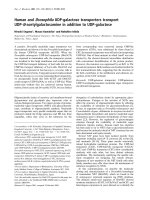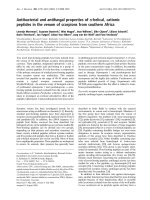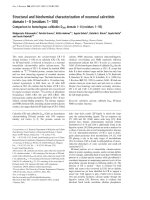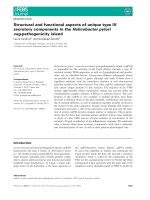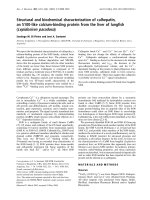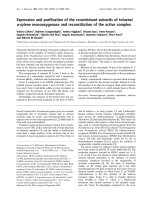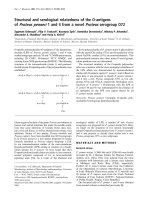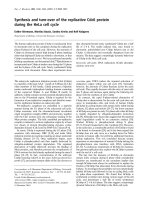Báo cáo Y học: Function and cellular localization of farnesoic acid O -methyltransferase (FAMeT) in the shrimp, Metapenaeus ensis ppt
Bạn đang xem bản rút gọn của tài liệu. Xem và tải ngay bản đầy đủ của tài liệu tại đây (300 KB, 9 trang )
Function and cellular localization of farnesoic acid
O
-methyltransferase (FAMeT) in the shrimp,
Metapenaeus ensis
Y. I. N. Silva Gunawardene
1
, S. S. Tobe
2
, W. G. Bendena
3
, B. K. C. Chow
1
, K. J. Yagi
2
and S M. Chan
1
1
Department of Zoology, The University of Hong Kong, Pokfulam Road, Hong Kong, China;
2
Department of Zoology,
University of Toronto, Ontario, Canada;
3
Department of Biology, Queen’s University, Kingston, Ontario, Canada
The isoprenoid methyl farnesoate (MF) has been impli-
cated in the regulation of crustacean development and
reproduction in conjunction with eyestalk molt inhibiting
hormones and ecdysteroids. Farnesoic acid O-methyl-
transferase (FAMeT) catalyzes the methylation of farne-
soic acid (FA) to produce MF in the terminal step of MF
synthesis. We have previously cloned and characterized
the shrimp FAMeT. In the present study, recombinant
FAMeT (rFAMeT) was produced for bioassay and anti-
serum generation. FAMeT is widely distributed in shrimp
tissues with the highest concentration observed in the
ventral nerve cord. Interestingly, an additional larger
protein in the eyestalk also showed immunoreactivity to
anti-FAMeT serum. FAMeT was localized in the neuro-
secretory cells of the X-organ-sinus gland complex of the
eyestalk. As shown by RT-PCR, FAMeT mRNA is
constitutively expressed throughout the molt cycle in the
eyestalk and the ventral nerve cord. To show that our
cloned gene product had FAMeT activity, we demon-
strated that expressed rFAMeT gene product catalyzed
the conversion of FA to MF in a radiochemical assay.
The ubiquitous distribution of FAMeT suggests that this
enzyme is involved in physiological processes in addition
to gametogenesis, oocyte maturation and development
and metamorphosis of the shrimp. We hypothesize that
FAMeT directly or indirectly (through MF) modulates the
reproduction and growth of crustaceans by interacting
with the eyestalk neuropeptides as a consequence of its
presence in the neurosecretory cells of the X-organ-sinus
gland.
Keywords: shrimp; farnesoic acid O-methyltransferase;
methyl farnesoate; neuropeptides; juvenile hormone.
Methyl farnesoate (MF), the sesquiterpenoid precursor of
the insect juvenile hormone III (JH III), is produced and
released by the mandibular organs of decapod crustaceans
[1]. The physiological function for MF is not well
understood in crustaceans. However, by analogy to the
established functions of JH III in insects, MF has been
suggested to play an important role in the regulation of
growth and reproduction in crustaceans [2–4]. In some
crustaceans, circulating titer and biosynthesis of MF
appear to be positively correlated with the maturation of
the ovary [5,6]. MF has also been suggested to play a role
in delaying the onset of molting in larval crustaceans [7,8].
This evidence implicates MF in both crustacean growth
and reproduction.
Farnesoic acid O-methyltransferase (FAMeT; also
known as S-adenosyl-methionine:farnesoic acid O-methyl-
transferase) is the enzyme that catalyses the final step in
the MF biosynthetic pathway in crustaceans [9,10].
FAMeT, also present in the insect corpora allata, carries
out the methylation of farnesoic acid (FA) to yield MF
using the cofactor S-adenosyl-
L
-methionine [9,11]. Varia-
tions in activity of the O-methyltransferase during devel-
opment appear to be an important component in the
regulation of JH biosynthesis in insects [10,12]. The rate-
limiting step controlling JH III biosynthesis in the cock-
roach larva is catalyzed by FAMeT [13]. Neuropeptides
released from the eyestalk X-organ sinus gland complex
appear to modulate the MF synthesis in the crustaceans
similar to the allatostatins repressing JH biosynthesis by
the corpora allata in insects [14–16]. This negative
regulation of MF biosynthesis occurs in part through
the inhibition of FAMeT activity [9,17]. Furthermore,
studies in insects have also demonstrated that allatostatins
are able to suppress the production of JH by modulating
O-methyltransferase and/or epoxidase activity [10]. Thus,
in both insects and crustaceans, O-methyltransferase plays
a role in the regulation of MF synthesis and thereby
mediates an effect on vitellogenesis and metamorphosis of
these animals through MF. In the shrimp, Metapenaeus
ensis, FAMeT mRNA is expressed throughout ovarian
maturation in the nerve and eyestalk suggesting a possible
role of FAMeT in the regulation of reproduction [18].
Coincidentally, the high levels of FAMeT mRNA tran-
scripts and protein in the eyestalk and the ventral nerve
cord in shrimp parallels the expression of some neuro-
peptides of the crustacean hyperglycemic hormone
(CHH)/gonad inhibiting hormone (GIH)/ molt inhibiting
hormone (MIH) family [18,19].
Correspondence to S. M. Chan, Department of
Zoology, The University of Hong Kong, Pokfulam Road,
Hong Kong, China. Fax: + 852 2299 0864,
E-mail:
Abbreviations: MF, methyl farnesoate; FAMeT, Farnesoic acid
O-methyltransferase; FA, farnesoic acid; JH III, insect juvenile
hormone III; IPTG, isopropyl thio-b-
D
-galactoside; CHH,
crustacean hyperglycemic hormone; MIH, molt inhibiting
hormone; GIH, gonad inhibiting hormone.
(Received 7 March 2002, revised 4 June 2002,
accepted 17 June 2002)
Eur. J. Biochem. 269, 3587–3595 (2002) Ó FEBS 2002 doi:10.1046/j.1432-1033.2002.03048.x
To understand the role of MF in the growth and
reproduction of crustaceans, considerable effort has been
invested in studying the regulation of the biosynthesis of
MF [1,4,6]. Although FAMeT has been implicated as a
potential point in the regulation of MF biosynthesis, the
biochemical and biological properties of the gene encoding
the FAMeT have not been characterized. Thus, the study of
the enzymes of the MF biosynthetic pathway will enable us
to better understand the role of MF in shrimp as well as its
probable structural and functional relationship with the
crustacean neuropeptides. We have previously reported on
the expression, cloning and characterization of the cDNA
encoding the FAMeT in the shrimp Metapenaeus ensis [18].
In the lobster, putative FAMeT clones have also been
isolated (GenBank no. U25846 and GenBank no.
AF249871) but the function of these genes has not yet been
demonstrated. Database searches also suggest that a
homologue for this gene exists in the Drosophila genome
[18]. Although there is a report on the cytosolic nature of
O-methyltransferase in the locust corpora allata, the cellular
localization/distribution of the enzymes of the MF biosyn-
thetic pathway remain unidentified [11]. In, this study, we
expressed recombinant (r) FAMeT in bacteria and deter-
mined its biological function by a radiochemical assay.
Antiserum raised against rFAMeT was used to localize
native FAMeT at the cellular level.
EXPERIMENTAL PROCEDURES
Construction of the shrimp FAMeT expression plasmid
The DNA fragment encoding the FAMeT coding sequence
(nucleotides 75–917; GenBank accession no. AF 333042)
was amplified using the primers FAOMX-F
4
(forward: 5¢-C
CGGGATCCATGGCTGACAACTGGCCTGCC-3¢)and
FAOMX-R
6
(reverse: 5¢-CGGGGTACCTTAGAATTCG
AACTTCCACTT-3¢) by PCR. Following amplification the
cDNA fragment was digested with BamHI and KpnIand
ligated into the BamHI, KpnI-digested vector pREST-A.
(Invitrogen, Groningen, the Netherlands). The ligated
product (pREST-A/rFAMeT) was transformed into E. coli
XL1-blue for DNA sequence determination. The pREST-A/
rFAMeT construct was transformed into BL21(DE3) cells
for protein expression. Overnight culture of a single colony
was diluted (1 : 200) with Luria–Bertani medium and
incubated at 37 °C with vigorous shaking to an D
600
of
0.3–0.5. IPTG was added at a final concentration of 1 m
M
to induce the protein expression for a period of 4 h. The
protein expression and cell growth was monitored by taking
1 mL of the bacterial culture at 1-h intervals. The protein
extract was analyzed by 12% SDS/PAGE and Western blot
analysis using Ni-nitrilotriacetic acid–alkaline phosphatase
conjugate or mouse anti-histidine IgG as the first antibody
and a goat anti-mouse IgG–alkaline phosphatase conjugate
as the secondary antibody.
Purification of rFAMeT
Bacteria were pelleted by centrifugation and resuspended
in 15 mL binding buffer (20 m
M
Tris/HCl pH 7.9,
0.5 m
M
NaCl and 5 m
M
imidazole). The cells were
homogenized with a Polytron and centrifuged at 5700 g
for 15 min. The pellet was suspended in 15 mL denatured
binding buffer (8
M
urea in binding buffer) and agitated
for 2 h at room temperature. Following centrifugation as
above, the supernatant was collected and loaded onto a
Ni-nitrilotriacetic acid–agarose (Qiagen, Hilden, Germany)
affinity column (pre-equilibrated with denatured binding
buffer). Denatured binding buffer was used to wash the
column until zero absorbency (280 nm) was observed in
the eluate. The fusion protein was eluted with an elution
buffer (6 m
M
Tris/HCl, pH 7.9, 0.15
M
NaCl and 300 m
M
imidazole, 8
M
urea) and dialyzed in a buffer (0.01%
SDS, 0.1% Tween 20, 0.1 · NaCl/Tris (0.8 g NaCl,
0.02 g KCl and 0.3 g Tris base in 1 L of water, pH 7.4) at
4 °C overnight. A second and a third dialysis were
performed for 10 h in 0.1 · NaCl/Tris and 0.1 · NaCl/P
i
(0.8 g NaCl, 0.02 g KCl, 0.144 g Na
2
HPO
4
and 0.024 g
KH
2
O
4
in 1 L of water, pH 7.4), respectively. A protein
assay kit (Bio-Rad) was used to determine the protein
concentration.
Production of anti-rFAMeT serum
Purified rFAMeT (50 mgÆmL
)1
in NaCl/P
i
) was mixed
with equal volume of complete Freund’s adjuvant (Gibco)
by homogenization with a Polytron. The emulsion was
injected into a New Zealand white rabbit subcutaneously
at three different sites. During the injections and subse-
quent handling of the animal, principles of laboratory
animal care and specific national laws were followed. The
rFAMeT used for the second and third booster injections
were mixed with an equal volume of incomplete Freund’s
adjuvant. The second and third injections (100 lg) were
given at 10-day intervals. A week after the third injection,
the antibody titer was monitored by SDS/PAGE and
Western blot analysis. The anti-rFAMeT serum was
prepared from the rabbit whole blood by centrifugation
at 800 g for 15 min and the supernatant was stored
at )80 °C in aliquots.
Detection of FAMeT in shrimp tissue protein extracts
Shrimp (8–10 g) were purchased from a local sea food
market and immediately transferred to sea water aquaria
held at ambient photoperiod and temperature. The molt
staging of the animals was performed by pleopod
setogenesis [20] and the female reproductive stage was
determined by the gonadal-somatic index. Different
tissues from the shrimps were dissected under NaCl/P
i
and homogenized in 1 mL per 50 mg (wet tissue weight)
of homogenization buffer (0.1
M
NaCl, 0.05
M
Tris, 0.1%
Tween-20, 1 m
M
phenylmethanesulfonyl fluoride and
1 lgÆmL
)1
aprotinin; pH 7.8). The homogenate was
centrifuged at 3000 g for 5 min The supernatant was
collected and centrifuged at 17 000 g for 40 min. This
successive supernatant containing the total protein extract
was analyzed by 10% SDS/PAGE and Western blot
detection with anti-rFAMeT serum as the primary
antibody (1 : 20 000) and the goat anti-rabbit IgG–
alkaline phosphatase conjugate as the second antibody
(1 : 5000). The negative control was detected with
preimmune rabbit serum (1 : 1000) as the primary
antibody. To test for specificity of the anti-rFAMeT
serum duplicate Western blots of shrimp protein extracts
were detected with anti-rCHH and anti-rMIH serum [23].
3588 Y. I. N. Silva Gunawardene et al. (Eur. J. Biochem. 269) Ó FEBS 2002
Signals were visualized by adding 5-bromo-4-chloro-
3-indolyl phosphate/Nitro Blue tetrazolium/alkaline phos-
phatase detection buffer and the colour reaction was
terminated with running tap water. Protein concentration
in the shrimp extracts was determined using a Bio-Rad
protein assay kit.
Immunocytochemical detection of FAMeT
in shrimp eyestalk
Different tissues from the shrimp were dissected under
cold NaCl/P
i
. The rigid cuticle containing most of the
retina and the lamina layer of the eyestalk was removed
and the tissues were immediately fixed in Bouin’s fixative
at 4 °C for 24 h, dehydrated and embedded in paraffin.
Consecutive 7-lm sections were mounted onto slides and
dried at 37 °C overnight. Tissue sections were deparaf-
finized in xylene (twice for 5 min) and rehydrated
through an ethanol series. The endogenous peroxidase
was removed by incubating the tissue sections in 0.3%
H
2
O
2
in methanol for 30 min at room temperature and
rinsed briefly with NaCl/P
i
. The immunocytochemical
staining of the tissue sections were performed with a
Vectastain Elite ABC kit (Vector Laboratories, CA, USA)
according to the manufacturers instructions. Tissue sec-
tions were blocked in normal blocking serum (provided
with the kit) for 30 min at room temperature. After
blotting the excess blocking serum, the sections were
incubated in the anti-rFAMeT serum (1 : 3000 dilution in
NaCl/P
i
buffer) overnight at 4 °C. The control sections
were incubated in preimmunized rabbit serum (1 : 400
dilution). The slides were washed with a large volume of
NaCl/P
i
under gentle agitation twice for 5 min each and
incubated in a biotinylated secondary antibody solution
(diluted according to the manufacturers instructions) for
30 min at room temperature. After the washing of the
slides for 5 min in a large volume of NaCl/P
i
,the
sections were incubated for 30 min with Vectastain Elite
ABC reagent according to the manufacturers instructions.
The slides were washed with NaCl/P
i
for 5 min and
incubated in the peroxidase substrate solution containing
0.01% H
2
O
2
and 1.39 m
M
3,3¢-diaminobenzidine (Sigma,
St Louis, MO, USA). The colour reaction was terminated
by rinsing the slides in running tap water. The sections
were dehydrated through increasing concentrations of
ethanol, cleared with xylene and mounted with coverslips
in DPX mountant (Sigma).
RT-PCR and Southern blot detection of FAMeT
Nervous tissue and eyestalks were extracted for total
RNA [21]. RNA quality was monitored by agarose gel
electrophoresis. The first strand cDNA was synthesized by
reverse transcription in a buffer containing 1–5 lgtotal
RNA, 2 pmol of gene specific primer, 2 m
M
dNTP mix,
2.5 m
M
MgCl
2
and 1 U of Superscript II reverse tran-
scriptase (Life Technologies, USA) at 42 °Cfor3h.A
pair of primers (forward: FAOM F
4
5¢-CCGGGATCCA
TGGCTGACAACTGGCCTGCC-3¢;reverse:FAOMR
6
5¢-CGGGGTACCTTAGAATTCGAACTTCCACTT-3¢)
PCR mix consisted of 2 lL of the RT reaction mix, 2 m
M
MgCl
2
,2m
M
of dNTP, 1 U of Taq DNA polymerase
and10pmolofeachprimerin1· PCR buffer. PCR
included denaturation at 95 °C for 1 min, annealing at
55 °C for 1 min and extension at 72 °Cfor1minfor35
cycles and an extension at 72 °C for 10 min for the
completion of the DNA synthesis. PCR products were
analyzed on a 1% agarose gel and blotted onto a nylon
membrane (Amersham) and cross-linked with UV irradi-
ation. The membrane was hybridized overnight at 42 °C
to a DIG-labeled nonradioactive cDNA probe of 843 bp
in a buffer (5 · NaCl/Cit, 0.5% SDS, 5 · Denhardt’s
solution and denatured salmon sperm DNA
(100 lgÆmL
)1
) with 50% formamide). The membrane
was then washed twice in 2 · NaCl/Cit with 0.1% SDS
for 5 min at room temperature and finally at 68 °Cin
0.5 · NaCl/Cit containing 0.1% SDS twice for 15 min.
Positive signals were detected with DIG–alkaline
phosphatase alkaline conjugate by adding Nitro Blue
tetrazolium (5%) and 5-bromo-4-chloro-3-indolyl phos-
phate (5%) to the detection buffer (0.1
M
Tris/HCl,
pH 9.5, 0.1
M
NaCl).
Enzyme preparation
Transformed bacteria BL21 (DE3) containing the expres-
sion plasmid construct was cultured as stated above.
Following induction with isopropyl thio-b-
D
-galactoside
(IPTG) the bacterial culture was grown at 37 °Cwith
shaking for 2.5 h. The bacterial cells were pelleted by
centrifugation at 800 g for 20 min. The bacteria pellet was
then resuspended in NaCl/P
i
buffer containing 1 m
M
phenylmethanesulfonyl fluoride and 1 lgÆmL
)1
aprotinin
and the cells lysed by a Polytron homogenizer. Following
centrifugation at 10 000 g for 30 min at 4 °C, the superna-
tantwasusedtotestforO-methyltransferase activity. The
BL21 (DE3) with expression vector only was used as a
negative control to check for any bacterial O-methyltrans-
ferase activity.
Methyltransferase assay
The O-methyltransferase activity of rFAMeT was assayed
according to the procedure of Reibstein & Law and
Feyereisen et al. [11,22] with some modifications. The
enzyme preparations were incubated in a final volume of
100 lL of 100 m
M
phosphate buffer (pH 7.2, containing
1m
M
EDTA, 1 m
M
2-mercaptoethanol and 1% BSA)
with 0.4 l
M
[
3
H]S-adenosyl-
L
-methionine (SAM), 30 l
M
farnesoic acid and 1.0 m
M
unlabeled SAM for 45 min at
37 °C. The reaction was stopped by the addition of
200 lL methanol and 100 lL1%Na-EDTA.Cold
carriers (20 lg JH III and 20 lg MF) were added to the
reaction mixture prior to extraction with chloroform
(2· 750 lL). After passing the chloroform phase through
anhydrous Na
2
SO
4
, the extracts were dried under N
2
,
redissolved in diethyl ether and applied to TLC plates
(Merck silica gel 60 F
254
plastic sheet). The samples were
then focused twice with methanol. After development in a
solvent system of toluene/ethyl acetate/acetic acid
(85 : 15 : 1, v/v/v), the bands corresponding to MF and
JH III were cut out and assayed for radioactivity by liquid
scintillation spectrometry. The absolute enzyme activity of
rFAMeT was obtained by subtracting background and
bacterial activity from the above results of the rFAMeT
assay.
Ó FEBS 2002 Shrimp farnesoic acid O-methyltransferase (Eur. J. Biochem. 269) 3589
RESULTS
Bacterial expression of the recombinant FAMeT
The rFAMeT protein was detected by using either the
Ni-nitrilotriacetic acid–alkaline phosphatase conjugate or
the mouse anti-(His-tag) IgG [23]. At different time points
(0–4 h) after induction with IPTG, the recombinant protein
of the expected size was detected on Western blots of the
protein samples obtained from the cell pellets (Fig. 1A, II).
The maximal expression of the rFAMeT in E. coli was
observed 2.5 h after the IPTG induction (Fig. 1A, I,II).
Furthermore, the expression of rFAMeT in the positive
expression constructs is specific because no positive bands
were detected in the bacterial controls (Fig. 1A, II). The
molecular mass of the detected rFAMeT band was
35 kDa, which was the expected size of the fusion protein.
Purification of rFAMeT and production
and specificity of anti-rFAMeT serum
Due to the presence of expressed rFAMeT in inclusion
bodies, the protein remained insoluble following lysis of the
bacterial pellet. At high concentrations of denaturing
reagents, such as urea and guanidine thiocyanate, most of
the inclusion bodies were soluble in solution. Western blot
analysis at different steps of the purification process
indicated that this method enables the complete purification
of rFAMeT with no contaminants (data not shown). To
renature the protein following elution, the protein was first
dialyzed in NaCl/Tris to remove urea and imidazole and the
protein was further dialyzed against NaCl/Tris and NaCl/P
i
to remove the detergent. The yield for rFAMeT in the
E. coli pRSET expression system was approximately
3mgÆL
)1
.
Antiserum against Ni-nitrilotriacetic acid affinity-purified
rFAMeT was raised by injecting rabbits with the renatured
protein. The titer and specificity of the antiserum were
determined by Western blot analysis (Figs 1B, I,II). The
results indicated that the antiserum was highly specific as it
detected only the rFAMeT in the cell lysate (Fig. 1B, II)
with a dilution of 1 : 160 000.
Tissue distribution and immunolocalization
of native FAMeT in shrimp
The results of Western blot analysis indicated the presence
of FAMeT in the ventral nerve cord, epidermis, eyestalk,
heart, tail muscle, mandibular organ, ovary and testis
(Fig. 2A,B). The strongest signal was observed for the
ventral nerve cord whereas no positive signals were detected
for the hepatopancreas and the mid gut (Fig. 2A,B). The
molecular mass (32 kDa) of the protein was in accordance
with that predicted from the amino-acid sequence deduced
from the cDNA [18]. In addition, a larger protein of
approximately 44 kDa unique to the eyestalk was detected
in both the male and the female shrimps (Fig. 2A,B). To
determine whether the distribution of the FAMeT varied
between adult and juvenile shrimp, total protein of the
eyestalk and ventral nerve cord of the juvenile shrimps were
analyzed. The results indicate that FAMeT is present in
both developmental stages in the eyestalk and the ventral
nerve cord (Fig. 2C). Furthermore, the larger protein (i.e.
44 kDa) was also observed in the juvenile eyestalk (Fig. 2C).
Fig. 1. SDS/PAGE and Western blot analysis of the expression of rFAMeT protein in pREST-A/BL21 (DE3) (A) and titering of rabbit antiserum
against rFAMeT protein by Western Blot (B). (A) (I) Cell lysates were prepared at different induction time points and proteins analyzed on a 12%
SDS/PAGE that was stained with Commassie Blue. (II) A 1 : 1000 dilution of the Ni-nitrilotriacetic acid–alkaline phosphatase conjugate was used
in the Western blot analysis to detect the His-tag rFAMeT fusion protein. The numbers on top indicate the induction time. All lanes show the
soluble fraction except 4P, which indicate the insoluble fraction of the lysed cell pellet. The lysate of only bacteria BL21 (DE3) or pREST-A vector
transformed BL21 (DE3) were used as controls. (B) (I) 200 ng of rFAMeT proteins (lanes 1 and 4–10) and whole bacterial lysate (lane 2) were
analyzed by 12% SDS/PAGE and transferred to Hybond-C membrane. (II) Individual lanes were immunostained with different dilutions of rabbit
antiserum against rFAMeT. PM, prestained standard protein marker. The last lane was the Western blot with preimmune rabbit antiserum.
3590 Y. I. N. Silva Gunawardene et al. (Eur. J. Biochem. 269) Ó FEBS 2002
Immunocytochemistry of serial sections of the eyestalk
revealed the presence of the FAMeT in the sinus gland, the
X-organ neurosecretory cell clusters together with the
lamina ganglionaries and the nerve fibers of the three
ganglia of the eye: the medulla externa, medulla interna and
the medulla terminalis (Fig. 3A). The sinus gland, located
between the medulla externa and interna of shrimp eyestalk
show strong immunoreactivity to anti-rFAMeT serum
(Fig. 3A). The neurosecretory cells and the laminar struc-
ture of the onion bodies of the X-organ [24] show the
highest immunoreactivity to the anti-rFAMeT serum in the
M. ensis eyestalk (Fig. 3B).
Expression of the FAMeT at different molting stages
The expression of the FAMeT mRNA during the molt cycle
was analyzed to ascertain whether the expression of FAMeT
gene is related to the molting cycle in the shrimp. Because of
the limited quantity of RNA obtained from ventral nerve
cord and eyestalk of a single shrimp, RT-PCR was employed
to study the expression of FAMeT. The results revealed that
FAMeT mRNA is expressed throughout the intermolt (stage
C), premolt (stage D) and postmolt (stages A, B) stages in
both adult and the juvenile shrimp in the eyestalk tissue
(Figs 4A,B). Similarly, FAMeT is also expressed in the
ventral nerve cord of both juvenile and adult animals during
all stages of the molt cycle (Fig. 4C,D). However, there is no
significant variation in the level of expression in the ventral
nerve cord and the eyestalk during the molt cycle. Further
analysis indicated that the FAMeT mRNA is expressed in
adults of both sexes throughout the molting cycle (Fig. 4B).
However, in the eyestalk of juvenile premolt animals the
FAMeT mRNA is expressed onlyin some shrimps (Fig. 4A).
To further confirm the RT-PCR results, a Southern hybrid-
ization was carried out on the RT-PCR products with a
cDNA-specific probe (Fig. 4A–D, III) and b-actin RT-PCR
amplification was used as an internal control to show the
integrity of the RNA samples (Figs 4A–D, II).
Fig. 2. Western blot analysis of proteins from different tissues of the
M. ensis. (A) Detection of FAMeT in M. ensis.Lanesareprotein
samples from different tissues of the Female shrimp. (B) Detection of
M. ensis FAMeT native protein in different tissues of the male shrimp.
The last lane indicates protein sample from testis. (C) Detection of
M. ensis FAMeT native protein in ventral nerve cord and eyestalk
tissues of the juvenile shrimp.
Fig. 3. Cellular localization of FAMeT in shrimp. (A) Immunolocal-
ization of FAMeT in eyestalk sections. (B) Higher magnifications (see
rectangle in A). XO, X-organ; SG, sinus gland; ME, medulla externa;
MI, medulla interna; MT, medulla terminalis; LAM, lamina gangli-
onaris;NGF,nerveandglialfibers;AT,axonaltract;ON,opticnerve;
OB, onion bodies of the X-organ; NSC, neurosecretory cells of the
X-organ.
Ó FEBS 2002 Shrimp farnesoic acid O-methyltransferase (Eur. J. Biochem. 269) 3591
Radiochemical assay for the functional analysis
of rFAMeT
To obtain a large quantity of FAMeT for the functional
assay, we expressed the rFAMeT in a pRSET bacterial
expression system. The O-methyltransferase assay was
carried out with the rFAMeT to check for presence of
enzyme activity. As shown in Fig. 5, MF production
increased in relation to the increasing amounts of rFAMeT.
However, when the protein quantity was increased beyond
17.5 lg, the enzyme activity was relatively constant (Fig. 5).
The data shown in Fig. 5 indicated the absolute enzyme
activity for each of the samples following the subtraction of
bacterial or background activity.
DISCUSSION
The insect JH-related compound MF is produced and
released by the mandibular organ of crustaceans [5,25,26].
MF is thought to be involved in both reproduction and
molting in the crustaceans [5,7]. FAMeT catalyzes the
methylation of FA to MF as the terminal step in the MF
biosynthetic pathway. Changes in O-methyltransferase
activity during development in insect corpora allata have
been suggested to be important components in the regula-
tion of JH biosynthesis [9]. Hence, the present study was
carried out to determine the biochemical function of the
shrimp FAMeT gene and cellular distribution of native
FAMeT enzyme, in an attempt to investigate the biochemi-
cal and biological properties and the regulation of MF
production in M. ensis. Using the bacterial expression
system, a recombinant protein of 35 kDa was produced
(Fig. 1A, II). This protein is 3 kDa larger than the predicted
molecularmassoftheFAMeTprotein(32kDa)asaresult
of the addition of several amino acids at the N-terminal end
of the fusion protein. The rFAMeT was purified through an
affinity column with the aide of the series of His
6
-tag
residues in the fusion protein, which function as a metal
binding domain. The His
6
-tag residues further assist the
subsequent analysis of the purification by Western detection
of the fusion protein with Ni-nitrilotriacetic acid conjugate.
The results from the Western blot indicate the anti-rFAMeT
serum specifically detected rFAMeT in the cell lysate
demonstrating the high specificity of the antiserum (Fig. 1B,
II) and the wide distribution in nature of the FAMeT in
shrimp (Fig. 2). The anti-rFAMeT serum detects the
highest level of the FAMeT in ventral nerve cord tissue,
whereas FAMeT level is lower in the epidermis, eyestalk,
heart, tail muscle, mandibular organ, ovary and testis
(Figs 2A,B). This observation agrees with the results of our
earlier study on the expression of the FAMeT mRNA [18].
However, in contrast to results from RT-PCR [18], FAMeT
is not present in the hepatopancreas by Western blot
analysis (Figs 2A,B). Northern blot analysis [18] suggests
that FAMeT mRNA level is much lower in hepatopancreas
than ventral nerve cord, tail muscle or testes and thus,
FAMeT expression in this tissue may be below the
sensitivity of this assay. Alternatively, FAMeT may be
Fig. 5. Methyl farnesoate production by different quantities of rFA-
MeT. Each point represents the mean ± STDEV of five determina-
tions.
Fig. 4. RT-PCR detection of the FAMeT
transcripts at different molting stages in
M. ensis eyestalk (ES) and ventral nerve cord
(VNC). (A) Expression of the FAMeT of
M. ensis at different molting stages in the
juvenile eyestalk. (B) Expression of the
FAMeT of M. ensis in the eyestalk at different
molting stages in the adult males and females.
(C)ExpressionoftheFAMeT of M. ensis at
different molting stages in the adult ventral
nerve cord. (D) Expression of the FAMeT of
M. ensis at different molting stages in the
juvenile ventral nerve cord. (A–D, I), RT-PCR
detection of M. ensis FAMeT transcripts at
different molting stages of the shrimp; (A–D,
II), RT-PCR detection of the shrimp b-actin
gene using gene-specific primers; and (A–D,
III) Southern blot analysis of FAMeT
RT-PCR products with cDNA coding region
probe.
3592 Y. I. N. Silva Gunawardene et al. (Eur. J. Biochem. 269) Ó FEBS 2002
secreted from the hepatopanceas. However, extensive work
will be required to determine the definite role of FAMeT in
the shrimp hepatopancreatic tissue. Surprisingly, the man-
dibular organ elicits a weak signal for FAMeT in compar-
ison to ventral nerve cord and other tissues (Fig. 2A,B).
This suggests that the last step of MF biosynthesis catalysed
by FAMeT enzyme occurs in many tissues. FA has been
implicated as a major product of release from the mandib-
ular organ in the crustaceans [26]. Similar reports have also
been documented in the insects where the JH-acids released
from the corpora allata are converted to the corresponding
JHs in the male accessory reproductive glands [27]. The wide
distribution of the FAMeT in different shrimp tissues
further confirms our earlier speculation that the major part
of the FA is secreted from the mandibular organ and
transported to target tissues for final conversion to MF [18].
However, it is also possible that FAMeT methylates
substrates other than FA in tissues apart from mandibular
organ. In M. ensis, FAMeT is also found in the juvenile
ventral nerve cord and eyestalk tissues (Fig. 2C). In insects,
O-methyltransferase activity in the corpora allata of the
D. punctata has been reported to be high during the early
stages of development suggesting a possible regulatory role
for O-methyltransferase on JH biosynthesis at these stages
[10]. Similarly, the presence of FAMeT in these juvenile
tissues suggests that this protein could be an important
component in the regulation of MF synthesis during the
early developmental stages of the shrimp.
FAMeT was localized in the neurosecretory cells of the
X-organ sinus gland complex by immunocytochemical
detection (Fig. 3A). The X-organ-sinus gland complex, a
neurohemal organ of decapod crustaceans, is the site of
synthesis, storage and release of the neuropeptides of the
CHH/MIH/GIH family [19,28]. We have previously shown
that expression of the FAMeT in the eyestalk and ventral
nerve cord coincides with the expression of some of these
eyestalk neuropeptides [18,19]. Eyestalk neuropeptides of
the CHH/MIH/GIH family are also located in the neu-
rosecretory cells of the X-organ-sinus gland [19,23]. More-
over the results from previous studies indicate that in the
crab, the biosynthesis of MF in the mandibular organ is
regulated by an eyestalk neuropeptide, mandibular organ
inhibiting hormone [9,16,17]. Interestingly, a protein of a
larger molecular mass ( 44 kDa) was also detected in the
eyestalk of both the adult and juvenile M. ensis (Fig. 2A–
C). Analysis of FAMeT for protein modification signatures
(
PROSITE
) suggest that modification is unlikely to be
responsible for the shift in protein size observed. Therefore,
the occurrence of the larger protein in the eyestalk may be
attributable to binding of FAMeT with the eyestalk factors
related to MF biosynthesis in the shrimp. Another alterna-
tive is that the antiserum is simply recognizing in eyestalk
tissue, another protein with similar antigenic determinants.
However, further studies are required to ascertain the
significance of this larger protein.
Molting, a prerequisite for growth in arthropods, is under
direct control of neurohormones in the Crustacea [29,30].
There is also evidence supporting a regulatory role of MF in
the molting process of the crustaceans [31–33]. Therefore, to
ascertain the expression of FAMeT in relation to the
molting process of the shrimp, we determined the level of
expression of this gene during the molt cycle. In general, the
circulating hemolymph ecdysteroid titer remains low during
intermolt, increases rapidly during premolt and drops
precipitously prior to ecdysis in crustaceans [20,34,35].
According to our observations, FAMeT mRNA is
expressed in the ventral nerve cord and eyestalk throughout
the molt cycle in both the adult and juvenile shrimp
(Fig. 4A–D). Furthermore, analysis of FAMeT mRNA in
the eyestalk of the adult shrimp from both sexes gives
similar results (Fig. 4B). Because MF appears to be
involved in the regulation of molting, the expression of
FAMeT mRNA throughout the molting cycle is required
for the synthesis of MF. We have observed that FAMeT is
expressed in a sex-specific manner in the juvenile shrimp
[18]. Therefore the differential expression of FAMeT during
the premolt stage in juveniles (Fig. 4A) is likely to be related
to sex-specific expression in juvenile shrimps.
Our data from the assay of rFAMeT demonstrates that
the enzyme is able to produce a significant quantity of MF
(Fig. 5). This indicates that the FAMeT gene codes for a
functional farnesoic acid O-methyltransferase in M. ensis
and is the first demonstration of the biological function of
this gene. The refolding of the protein during renaturation is
important for the function of the enzyme. When we used
recombinant protein renatured following purification under
denaturing conditions, a very low enzyme activity was
observed. This is presumably a consequence of the incom-
plete refolding of the fusion protein. However, when we use
a partially purified rFAMeT extract in the subsequent
functional assays a significantly higher level of O-methyl-
transferase activity was observed (Fig. 5). Because the
enzyme activity attributable to the bacterial proteins or the
vector proteins (background very low and insignificant)
were subtracted from the final data of the rFAMeT enzyme
activity, the data shows the absolute level of O-methyl-
transferase activity of the recombinant protein. Although
the activity of rFAMeT is comparatively low when com-
pared to the native O-methyltransferase activity of crusta-
ceans and insects, the actual amounts of FAMeT in these
studies were unknown [10,25,26]. Moreover, it is well
known that bacterial expression systems commonly fail to
process the disulfide bonds and the correct refolding as a
consequence of the lack of post-translational modifications
in prokaryotes. Therefore, recombinant proteins from
bacterial systems usually have much lower activity than
the native proteins. This has been observed in other
recombinant proteins of the shrimp and also in other
recombinant proteins expressed in bacteria [19,36,37].
Hence, only a small fraction of the rFAMeT was expected
to fold in the correct conformation and consequently low
FAMeT activity in the functional assay.
In conclusion, the wide tissue distribution of the FAMeT
in shrimp implies that this gene may also be involved in
other physiological processes apart from its role in repro-
duction and metamorphosis. Further, the specific cellular
localization of FAMeT in the X-organ-sinus gland complex
suggests that FAMeT may interact with the eyestalk
neuropeptides and thereby regulate the synthesis and role
of MF. All this suggests that FAMeT is a key regulatory
enzyme in the MF biosynthetic pathway of the shrimp. In
addition, the occurrence of FAMeT mRNA throughout the
molting cycle suggests that FAMeT may be involved in
molting or related processes in the shrimp. Finally, the
present work provides a framework for study of the
regulation of biosynthesis and function of MF by FAMeT
Ó FEBS 2002 Shrimp farnesoic acid O-methyltransferase (Eur. J. Biochem. 269) 3593
and its mode of interaction with eyestalk neuropeptides to
establish definitive roles of MF in shrimp and all crusta-
ceans.
ACKNOWLEDGEMENTS
This work was supported by a RGC earmarked grant (# HKU 7227/
00M) awarded to S. M. C. by the Hong Kong SAR Government and
by operating grants from the Natural Sciences and Engineering
Research Council of Canada. Y. S. G. is the recipient of a Presidential
scholarship from the Sri Lankan Government and the J. G. Phillips
Memorial Scholarship from the University of Hong Kong.
REFERENCES
1. Tamone, S.L., Prestwich, G.D. & Chang, E.S. (1997) Identification
and characterization of methyl farnesoate binding proteins from
the crab, Cancer magister. Gen. Comp. Endocrinol. 105, 168–175.
2. Chaix, J.C. & De Reggi, M. (1982) Ecdysteroid levels during
ovarian development and embryogenesis in the spider crab
Acanthonyx lunulatus. Gen. Comp. Endocrinol. 47, 7–14.
3. Laufer, H., Landau, M., Borst, D.W. & Homola, E. (1986)
Advances in Reproduction, 4, (Andries, J.C. & Dhainaut, A., eds),
pp. 135–143. Amsterdam, Elsevier Science Publishers.
4. Laufer, H., Borst, D.W., Baker, F.C., Carrasco, M., Sinkus, M.,
Reuter, C.C., Tsai, L.W. & Schooley, D.A. (1987) Identification of
a juvenile hormone-like compound in crustacean. Science 235,
202–205.
5. Laufer, H., Landau, M., Homola, E. & Borst, D.W. (1987) Methyl
farnesoate; its site of synthesis and regulation of secretion in a
juvenile crustacean. Insect Biochem. 17, 1129–1131.
6. Sagi, A., Homola, E. & Laufer, H. (1991) Methyl farnesoate in the
prawn Macrobrachium rosenbergii: synthesis by the mandibular
organ in vitro, and titers in the hemolymph. Comp. Biochem.
Physiol. B. 99, 879–882.
7. Borst, D.W., Laufer, H., Landau, M., Chang, E.S., Hertz, W.A.,
Baker, F.C. & Schooley, D.A. (1987) Methyl farnesoate and its
role in crustacean reproduction and development. Insect Biochem.
17, 1123–1227.
8. Smith, P.A., Clare, A.S., Rees, H.H., Prescott, M.C., Wainwright,
G. & Thorndyke, M.C. (2000) Identification of methyl farnesoate
in the cypris larva of the barnacle, Balanus amphitrite,anditsrole
as a juvenile hormone. Insect Biochem. Mol. Biol. 30, 885–890.
9. Wainwright, G., Webster, S.G. & Rees, H.H. (1998) Neuropeptide
regulation of biosynthesis of the juvenoid, methyl farnesoate, in
the edible crab, Cancer pagurus. Biochem. J. 334, 651–657.
10. Wang, Z., Ding, Q., Yagi, K.J. & Tobe, S.S. (1994) Terminal
stages in juvenile hormone biosynthesis in Corpora Allata of
Diploptera punctata: development changes in enzyme activity and
regulation by allatostatins. J. Insect Physiol. 40, 217–223.
11. Feyereisen, R., Friedel, T. & Tobe, S.S. (1981) Farnesoic
acid stimulation of C
16
juvenile hormone biosynthesis by corpora
allata of adult female Diploptera punctata. Insect Biochem. 11,
401–409.
12. Tobe, S.S. & Clarke, N. (1985) The effect of 1-methionine con-
centration on juvenile hormone biosynthesis by corpora allata of
the cockroach Diploptera punctata. Insect Biochem. 15, 175–179.
13. Yagi, K.J., Konz, K.G., Stay, B. & Tobe, S.S. (1991) Production
and utilization of farnesoic acid in the juvenile hormone biosyn-
thetic pathway by corpora allata of larval Diploptera punctata.
Gen. Comp. Endocrinol. 81, 284–294.
14. Woodhead, A.P., Stay, B., Seidel, S.L., Khan, M.A. & Tobe, S.S.
(1989) Primary structure of four allatostatins: neuropeptide
inhibitors of juvenile hormone synthesis. Proc. Natl Acad. Sci.
USA 86, 5997–6001.
15. Kramer, S.J., Toschi, A., Miller, C.A., Kataoka, H., Quistad,
G.B., Li, J.P., Carney, R.L. & Schooley, D.A. (1991) Identification
of an allatostatin from the tobacco hornworm Manduca sexta.
Proc. Natl Acad. Sci. USA 88, 9458–9462.
16. Tsukimura, B. & Borst, D.W. (1992) Regulation of methyl far-
nesoate in the hemolymph and mandibular organ of the lobster,
Homarus americanus. Gen.Comp. Endocrinol. 86, 297–303.
17. Wainwright, G., Webster, S.G. & Rees, H.H. (1999) Involvement
of adenosine cyclic-3¢,5¢-monophosphate in the signal transduc-
tion pathway of mandibular organ-inhibiting hormone of the
edible crab, Cancer pagurus. Mol. Cell. Endocrinol. 154, 55–62.
18. Silva Gunawardene, Y.I.N., Chow, B.K.C., He, J.G. & Chan,
S.M. (2001) The shrimp FAMeT cDNA is encoded for a putative
enzyme involved in the methylfarnesoate (MF) biosynthetic
pathway and is temporally expressed in the eyestalk of different
sexes. Insect Biochem. Mol. Biol. 31, 1115–1124.
19. Gu, P.L., Yu, K.L. & Chan, S.M. (2000) Molecular character-
ization of an additional shrimp hyperglycemic hormone: cDNA
cloning, gene organization, expression and biological assay of
recombinant proteins. FEBS Lett. 472, 122–128.
20. Chan, S.M., Rankin, S.M. & Keeley, L.L. (1988) Characterization
of the molt stages in Penaeus vannamei: setogenesis and hemo-
lymph levels of protein, ecdysteroid and glucose. Biol. Bull. 175,
185–192.
21. Chomczynski, P. & Sacchi, N. (1987) Single-step method of RNA
isolation by acid guanidinium thiocyanate-phenol-chloroform
extraction. Anal. Biochem. 162, 156–159.
22. Reibstein, D. & Law, J.H. (1973) Enzymatic synthesis of insect
juvenile hormones. Biochem.Biophys.Res.Commun.55, 266–272.
23. Gu, P.L., Chu, K.H. & Chan, S.M. (2001) Bacterial expression of
the shrimp molt-inhibiting hormone (MIH): antibody production,
immunocytochemical study and biological assay. Cell Tissue Res.
303, 129–136.
24. Bell, T.A. & Lightner, D.V. (1988) A Handbook of Normal Penaeid
Shrimp Histology, 1st edn. pp. 26–33. The World Aquaculture
Society and Allen Press, Inc. Lawrence, Kansas, USA.
25. Tobe, S.S., Young, D.A. & Khoo, H.W. (1989) Production of
methyl farnesoate by the mandibular organs of the mud crab,
Scylla serrata: validation of a radiochemical assay. Gen.Comp.
Endocrinol. 73, 342–353.
26. Tobe, S.S., Young, D.A., Khoo, H.W. & Baker, F.C. (1989b)
Farnesoic acid as a major product of release from crustacean
mandibular organ in vitro. J. Exp. Zool. 249, 165–171.
27. Weirich, G.F. & Culver, M.G. (1979) S-Adenosylmethionine:
Juvenile hormone acid methyltransferase in male accessory
reproductive glands of Hyalophora cecropia (L.). Arch. Biochem.
Biophys. 198, 175–181.
28. Liu, L., Laufer, H., Wang, Y. & Hayes, T. (1997) A neuro-
hormone regulating both methyl farnesoate synthesis and glucose
metabolism in a crustacean. Biochem. Biophys. Res. Commun. 237,
694–701.
29. Webster, S.G. (1998) Neuropeptides inhibiting growth and
reproduction in Crustaceans. In Resent Advances in Arthropod
Endocrinology (eds G. M. Coast & S. G. Webster), pp. 33–52.
Cambridge University Press, UK.
30. Ding, Q. & Tobe, S.S. (1991) Production of farnesoic acid and
methyl farnesoate by mandibular organs of the cray fish,
Procambarus clarkii. Insect Biochem. 21, 285–291.
31. Byard, E., Shivers, R. & Aiken, D.E. (1975) The mandibular
organ of the lobster, Homarus americanus. Cell Tissue Res. 162,
13–22.
32. Taketomi, Y. & Kawano, Y. (1985) Ultrastructure of the man-
dibular organ of the shrimp, Penaeus japonicus, in untreated and
experimentally manipulated individuals. Cell Biol. Int. Report 9,
1069–1074.
33. Yamamoto, H., Okino, T., Yoshimura, E., Tachibana, A.,
Shimizu, K. & Fusetani, N. (1997) Methyl farnesoate induces
larval metamorphosis of the barnacle Balanus amphitrite via pro-
tein kinase C activation. J. Exp. Zool. 278, 349–355.
3594 Y. I. N. Silva Gunawardene et al. (Eur. J. Biochem. 269) Ó FEBS 2002
34. Chang, E.S. & Bruce, M.J. (1980) Ecdysteroid titers of juvenile
lobsters following molt induction. J.Exp. Zool. 214, 157–160.
35. Tamone, S.L. & Chang, E.S. (1993) Methyl farnesoate stimulates
ecdysteroid secretion from crab Y-organs in vitro. General Comp
Endocrinol. 89, 425–432.
36. Linser, P.J., Trapido-Rosenthal, H.G. & Orona, E. (1997)
Glutamine synthetase is a glial-specific marker in the olfactory
regions of the lobster (Panulirus argus) nervous system. Glia 20,
275–283.
37. Ren, X., Gao, S., You, D., Huang, H., Liu, Z., Mu, Y., Liu, J.,
Zhang, Y., Yan, G., Luo, G., Yang, T. & Shen, J. (2001) Cloning
and expression of a single-chain catalytic antibody that acts as a
glutathione peroxidase mimic with high catalytic efficiency.
Biochem. J. 359, 369–374.
Ó FEBS 2002 Shrimp farnesoic acid O-methyltransferase (Eur. J. Biochem. 269) 3595


